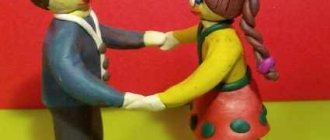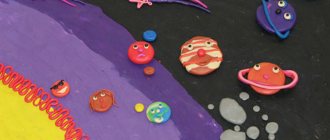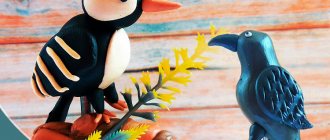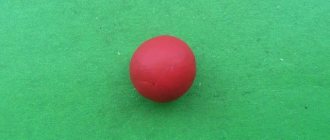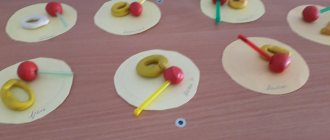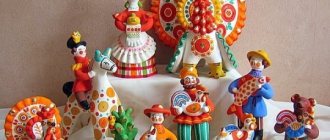"These funny cats." Thematic notes for older age. Modeling lesson “Cats-artists”
Elena Meleshko
“These funny cats.”
Thematic notes for older age. Sculpting lesson “Cats-Artists” Sculpting lesson in the senior group “
Cats-Artists ” .
Goal: To teach children to create an animal image in modeling . Strengthen the ability to sculpt from a whole piece using clay cuts from the ends. Use different techniques in work: rolling clay between the palms, pulling small parts, connecting parts by pressing and smoothing the joints. Learn to convey the pose of a cat in sculpting .
Preliminary work: Conversation about pets. Examination of illustrations in books, albums (image of animals by Yu. Vasnetsov,
E. Charushin). Reading of the poem by V. Shipunova “What the Siberian cat dreams of”
. Visit with parents to the Yu. Kuklachev Cat Theater. Looking at a toy cat.
Material: Clay, board, stack, cloth napkin (wet)
for each child, a
cat .
On the topic: methodological developments, presentations and notes
Date: February 21, 2012 Participants: children of the preparatory group Conducted by: educational psychologist Panova M.M. Purpose: to promote formation.
Introduce children to number and figure 6. Improve counting skills and comparison of subject aggregates. Form children’s ability to distinguish between the concepts of yesterday, today, tomorrow. Consolidate knowledge about geome.
1. Conduct classes to teach children to notice changes occurring in nature.2. Conducting classes, teaching children to group objects by color and shape.3. Conducting classes, Develop holistically in children.
Progress of the lesson:
Guys, you recently visited Yuri Kuklachev’s Cat Theater. Did you like performing cats ?
Children talk about their impressions.
— Do you want to make a cat and organize your own Cat Theater in our group?
- Then let's look at it. What shape is a cat's ?
- What kind of head does our cat ?
- What’s on the cat’s head ?
— Does our cat have a tail ? What is he like?
Long, oval, fluffy.
- How can you blind a cat ?
From pieces: from a ball - a head, from a cylinder - a torso, from small cylinders - legs and a tail.
- I’ll remind you of another sculpting that will help us sculpt cats and show how they move.
Divide the lump of clay in half - cut off in a stack; one half - for the body and paws; the other is for the head and tail. We make a cylinder from one part. Animals usually move on four legs, so the cylinder (roller)
you need to turn it like this
(the teacher turns the cylinder into a horizontal position)
. Then bend it in an arc and cut it at both ends with a stack to make four legs. This is a body with legs. All that remains is to sculpt the head and tail. Tell me how best to do this?
— You and I sculpt not just cats, but cats who are artists. Therefore, the body can be positioned as if the animal is standing on two legs, or on four. And the head can be attached to the body from above or to the side, on the neck or directly on the body.
— There are many artists in the Cat Theater. May you get different cats !
Children begin sculpting , independently choosing a pose for the sculpted cat .
At the end of the work, the teacher says:
- You made a cat , now let's see what your cat , what number it is showing us.
The teacher examines all the sculpted figures and notes the most expressive ones.
- Now let’s choose a place in the group for our Cat Theater so that it’s convenient to organize performances!
Summary of GCD for sculpting “Cat”. Senior group
Khadizhat Zalimkhazhievna
Abstract of the NOD for sculpting “Cat”. Senior group
Nod's summary of sculpting " Cat "
.
Senior group
Goal: creating conditions for developing the ability to sculpt a cat from a whole piece of plasticine, conveying the proportions of the animal.
Equipment: cat , plasticine, stacks, oilcloths.
Lesson summary for the senior group on modeling “Cats” from salt dough
Victoria Khaikina
Summary of a lesson in the senior group on sculpting from salt dough “Cats”
Program content:
Learn to create the image of an animal in sculpting, to convey the pose of a cat. Improve the technique of modeling salt dough. Reveal the direct connection between plastic form, material and technology. Learn to plan work: conceive an image, divide the material into the required number of parts of different sizes, sculpt in a rational way, sequentially, starting with large parts. Show techniques for decorating a sculpted figurine with additional materials. Develop an eye, a sense of shape and proportions.
Vocabulary work: Active vocabulary: pet, lonely, delay, smooth out.
Demonstration material: cat toy, samples of cat figurines (from dough).
Preliminary work with children: looking at illustrations, reading poems about cats, learning finger exercises, outdoor games, looking at the painting “Cat with Kittens.”
Equipment: modeling boards, stacks, water.
Progress of the lesson:
The children stand in a semicircle. The teacher comes in with a basket.
Guys, today one pet came to visit us. And in order to find out who is sitting there you need to guess the riddle:
What kind of animal is playing with me?
That's right, guys - it's a kitten. But he is very sad because he has no friends. How can you and I help him? (children's answers). Let us make friends out of dough for our kitten. Do you agree to help him? (children's answers).
Let's remember the rules for working with salt dough (do not hold it in your hands for a long time, so as not to dry it out; moisten the places where the parts are held together with water).
What geometric figure does our kitten’s body resemble? What shape is the tail?
We will sculpt from a whole piece of dough. First we will make a flat cake out of it, and then cut out a rectangle with a stack. Let's pull back the ears and paws. Separately, roll two identical balls, flatten them - the eyes; and make a sausage - tail. The tail should be thin and long. Roll a small ball and give it a triangular shape - a nose. We attach all the parts to the body, having previously lubricated the fastening points with water. Smooth out all edges and irregularities with wet fingers.
Guys, to warm up our hands before work, we will do some finger gymnastics.
Cunning little Kitten (ball held between palms)
Just got out of diapers (palms open)
Did a lot of things: (palms close)
Ate a fish from a raccoon (circular movements between palms)
I started a fight with a hamster (squeeze the ball in my right hand)
Summary of GCD for modeling in the middle group “Kitten”
Elena Konatyeva
Summary of GCD for modeling in the middle group “Kitten”
Summary of GCD for modeling in the middle group
Educator: Konatyeva Elena Viktorovna
Teach children to sculpt a four-legged animal - a cat.
Program content:
Reinforce sculpting techniques: rolling plasticine between palms; practice using pinching and pulling techniques; consolidate the ability to connect parts, pressing them tightly against each other, and smoothing seams; continue to introduce children to the properties of plasticine (soft, pliable, able to take any shape). Continue learning how to work with a plasticine stack.
Cultivate accuracy when working with plasticine. Cause a positive emotional response to the overall result.
Vocabulary work: stack, plasticine soft, pliable, multi-colored.
Preliminary work: conversations with children about pets, looking at illustrations, reading fiction and educational literature, riddles, didactic games: “Who lives where?”, “Where is whose cub?”, “Find out by description.”
Materials: plasticine on boards (for each child) and separately on plates, stacks, oilcloths, boards, a modeling support diagram with an image (a kitten, a magnetic board, a layout with multi-colored balls, a disk with background music for the practical part.
Organizing time.
Let's say "Hello!" each other.
Hi all!" and “Good afternoon!”;
Q: Guys, look, guests have come to us. Let's say hello to them. D: Good morning!
Q: Guys, come to me, please. Look what we have on the table?
Q: What kind of pet do you think likes to play with balls?
Q: Look how many glomeruli there are, are they the same? What color and shape are they?
D: red, yellow, etc. multi-colored, round.
Q: Guys, there are balls, but there is no one to play with them. What can we do?
Q: Let's make kittens so they can play with them.
Q: And in order for your ears to listen to me carefully, and your eyes to see what I’m going to show, let’s play with you.
Dynamic pause.
"Let's turn into kittens"
Wash your cheeks with your paw (act in accordance with the text)
Right eye left eye
Q: After being kittens, we turn into guys and sit down in our seats. We sit down straight, backs straight, eyes on me.
Q: And now I’ll show you how to make a kitten.
Here I have a large piece of plasticine. I tear off a smaller piece - this will be the head of our kitten. Now I tear off an even smaller piece from a larger piece - this will be the tail of our kitten. And from this remaining piece of plasticine I will sculpt the body of our kitten. I will roll this piece of plasticine into a sausage. Then I take the stack and make longitudinal cuts on both sides of this sausage. These will be our kitten's paws. Now we take a piece from which I will roll a ball - this will be the head of our kitten. The ball can be rolled between straight palms or between the palm and the table. Like this.
Preview:
on productive activities (modeling) for children of the older group
Create an image of an animal in sculpting; convey the pose of a kitten in sculpting.
Strengthen the ability to sculpt an animal figurine in parts, using different techniques: rolling clay between the palms, pulling out small parts, connecting parts by pressing and smoothing the joints.
Develop fine motor skills of children's hands.
Cultivate a love for pets.
Integration of OO: artistic and aesthetic development, cognitive.
Progress of the lesson: Children sit on chairs placed in a semicircle. The teacher comes in with a basket. Guys, today one pet came to visit us. But it is very sad, because he has no friends. And in order to find out who is sitting there, we need to solve several riddles.
What kind of animal is playing with me? Doesn't moo, doesn't neigh, doesn't bark, attacks balls, hides claws in its paws.
Mustachioed muzzle Striped fur coat Washes often But doesn’t know how to handle water.
He cries at the threshold, hides his claws, quietly enters the room, purrs and sings. That's right, guys - it's a kitten.
Do you agree to help him (children's answers). Let us make friends for our kitten from plasticine. And in order to make friends for him, we must pass several tests. 1. Does anyone know a poem about a cat? (reading a poem by Natalya). 2.The second task is called “What’s missing?” (finish the kitten) 3. Third task - “Fold a kitten from geometric shapes” (children take turns folding a kitten from geometric shapes).
The window opened (arms to the sides) The cat came out onto the ledge (cat’s smooth gait)
The cat looked up (the head was thrown up)
So we got to our modeling table. We have already sculpted a horse. Let's remember where to start sculpting (knead the plasticine and divide it into parts). What shape is a kitten's body? Head? Tail? (oval, elongated head, long tail). We will sculpt from a whole piece of plasticine. Tamara, tell us how we will sculpt (we need to roll out a thick sausage, cut it into a stack on both sides - these are the legs. Then we roll out the ball - stretch out the muzzle and ears. We attach the muzzle to the body and smear it well. The tail should be thin and long). Guys, to warm up our hands before work, we will do some finger exercises.
Cunning, little Kitten (ball squeezed between palms) Just got out of diapers, (palms open) Did a lot of things: (palms close) Ate a fish from a raccoon, (circular movements between palms) Started a fight with a hamster, (Squeeze the ball in your right hand) Only the dog was scared. (squeeze in left hand) Ill-mannered child (circular movements on the table with one hand) This little Kitten. (circular movements on the table with the other hand) Let's start sculpting. Children sculpt, the teacher helps individually as needed. Well done guys, you all coped with the task. Now our cat is very happy, and thanks you all for new friends.

